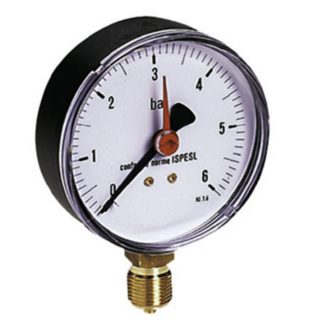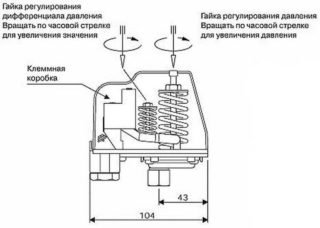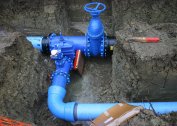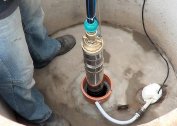For comfortable use of the water supply network, the pressure of the water stream is required in accordance with the standards. These indicators affect the operability and serviceability of the pumping device and sanitary appliances. If you know what water pressure should be in an autonomous water supply in a private house, the values can really be adjusted.
Optimal values for a private house
Measure the pressure in the water supply line in bars and in atmospheres. The difference in both values is small - up to hundredths of units. At a pressure of one atmosphere, the water flow reaches a height of up to 10 m.
According to SNiP 2.0401-85, the norms for cold water vary from 0.3 to 6 bar, for hot - from 0.3 to 4.5.
In centralized highways, the pressure indicator usually corresponds to 4–4.5 bar. This value is enough to serve high-rise buildings. Residents of private houses have to make payments individually. If autonomous water supply is installed, it is possible to increase the pressure indicators in the water supply system more than those approved in the regulatory documentation. They vary in the range of 2.5–7.5 bar, and sometimes increase to 10 bar.
The standard criteria for the normal functioning of the pipeline with a pressure pump are in the range 1.4–2.8 bar, which is consistent with the pressure switches set at the factory.
The determination of the necessary water pressure for the normal operation of the autonomous water supply system is carried out taking into account the applied plumbing fixtures:
- a jacuzzi will require a pressure of four bars;
- for a bath, shower, fire extinguishing equipment - one and a half bars;
- for a washing machine - in two bars;
- for watering work - five bar.
The optimal value of the working pressure for a private house is at around four bars. This pressure is enough for the normal operation of all plumbing fixtures. Most of the fittings, valves and control valves can withstand it without breakage.
If the pressure is too large, especially sensitive devices will break or malfunction. For this reason, it should not increase beyond 6.5 bar.
Pressure in gushing artesian wells reaches 10 bar. Only welded joints can withstand such a pressure, but most of the fittings, valves and valves under its influence fail, due to which leaks appear at the places of their installation.
How to measure pressure
A manometer is used for measurement in the water supply system. It is installed next to the water meter at the point of entry of the water pipe into the building. Also, heating boilers are equipped with an integrated device. The manometer allows you to independently measure the actual values and compare them with those that comply with technological standards and GOSTs.
Monitor the performance of this device is required regularly. Indeed, at low values, the water jet at water consumers will be extremely weak.
Exceeding the standards poses a danger to plumbing and household appliances. The water pressure gauge is equipped with a measuring scale with a maximum of seven atmospheres: when the pressure rises above this indicator, major malfunctions form in the network. Leaks occur at the joints of the pipe segments, and the sensitive elements break.
Reasons for increase and decrease
Most often, low pressure occurs due to wear of the water pipes - if they are rusted or clogged with limescale. The latter occurs not only over time, but also because of too hard water. In this situation, the pipeline needs to be replaced; there is no other solution to the problem of low pressure.
Other reasons that there is no normal pressure in the water supply system in a private house include:
- Weak pressure unit. In non-centralized pipelines, water needs to be raised from the aquifer and brought to all water consumers located at different distances from the pumping device and located at different heights.
- Low well production. While the mine is filled with water, the pressure in the water supply will not drop, but as the source is emptied, the pressure will begin to decrease, and then the liquid will cease to flow into the pipeline.
- Opening all consumers at once. This causes a decrease in pressure in the line. Therefore, when performing design work, the total number of water consumers that can be opened immediately is taken into account.
As for excessively high pressure, it arises both because of improperly selected pressure equipment - which is excessively powerful, and because of the formation of air jams in the water supply pipeline.
Pressure Adjustment Methods
Adjusting the pressure switch helps to reduce the pressure. A reduction of less than 1.5 atmospheres is not allowed, the optimum value is 3-4 bar. Ideally, it is worth installing an automatic system that will control the operation of the equipment without human intervention.
Also, pressure relief valves are used to reduce pressure. If this value is exceeded, the compensator discharges the excess amount of water into the sewer system.
You can increase the pressure by setting:
- booster pumping device;
- accumulator with a membrane;
- storage capacity.
You can also replace the installed pumping equipment with more powerful.
It is rational to include a booster in the wiring for a forced increase in pressure when there is a sufficient amount of liquid in the source, but it arrives at remote or at high altitude consumption points with a large loss of pressure. For example, if the building has more than one floor. Management is possible both manually and automatically. The second option has a significant plus - control of the start and stop of the pump, when necessary, the automation performs independently.
With insufficient flow rate, the use of a booster pump will only aggravate the problem.
In such a situation, only installing a membrane accumulator will help. The rubber diaphragm divides the hydraulic tank into two compartments - air and water. The space between the membrane surface and the housing of the hydraulic accumulator is filled with high pressure air. Due to this, the water flow under the required pressure flows to each consumer. Such a scheme allows you to exclude pressure differences and water hammer, to ensure uninterrupted operation of all elements of the highway.
Another method is the use of a large storage tank. If you install it in the highest place of the house, it will be filled through the main pump, and by gravity to the user. But to achieve a decent pressure in such a situation is unlikely to succeed. It is better to purchase an additional pump for pumping fluid from the drive. Then the tank can be placed anywhere, even in the basement.
Before choosing a method that allows you to increase the pressure in the water supply network, it is worth calling a specialist. He will check the condition of the filter element, shutoff valves, and also perform the correct pressure measurements.





